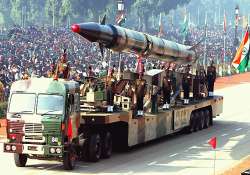India To Join ICBM League Soon With Russian Help
New Delhi, Oct 8: India is all set to join the select group of nations capable of launching nuclear strikes across continent, reports The Pioneer.With Russia ready to provide the cutting-edge “seeker” technology for India's

New Delhi, Oct 8: India is all set to join the select group of nations capable of launching nuclear strikes across continent, reports The Pioneer.
With Russia ready to provide the cutting-edge “seeker” technology for India's Agni-V intercontinental ballistic missile (ICBM), the country is ready to flaunt its nuclear might in a big way by year end when the ICBM will undergo its maiden launch.
The development of the ICBM had been delayed because no country was ready to provide India the crucial ‘seekers' technology, which enables the missile to home in on the target with pinpoint precision.
The ICBM will be capable of carrying nuclear payload and has a strike range of 10,000 km.
The Defence Research and Development Organisation (DRDO) has indigenously developed the ‘seeker' technology for Agni-I, Agni-II and Agni-III intermediate range missiles. But the DRDO was not in a position to develop the next stage technology and efforts to import it had been futile so far.
The breakthrough with Russia for the most critical system of the ICBM came after extensive talks between delegations of the two countries during Defence Minister AK Antony's three-day visit to Moscow earlier this week.
The Indian delegation comprised senior missile scientists of the DRDO besides others, and Moscow agreed to help New Delhi for the ICBM project, sources said.
The two sides met to review progress on various defence projects under the India-Russia Inter-Governmental Commission on Military Technical Co-operation set up a decade back.
The Defence Ministers of the two countries head this body and meet once a year either in Moscow or New Delhi.
Russia, UK, the US, France and China are the only countries in the world to have ICBMs which can hit a target beyond 10,000 km. India has successfully developed intermediate range ballistic missiles capable of carrying nuclear weapons and hitting a target less than 4,000 km.
With the successful launch of the Agni-III two years back, the Indian scientists displayed their capability to even develop ICBM. However, their efforts over the last two years or so to go ahead with Agni-V launch could not progress due to non-availability of ‘seeker' technology.
“Given discriminatory attitude against India by some advanced countries, including the US vis-à-vis sharing advanced technology over the last two decades, it was tough going for the missile project scientists till Russia agreed to come to India's rescue,” officials said.
They said Russia was more than willing to share technical know-how with India for its missile programme and time tested defence relations between the two countries spanning more than four decades again produced positive results, sources said.
In another important development, Russia will also share its advanced GPS system for military purposes with India.
The US has been reluctant to do so despite repeated assurances by Washington that it is ready to open its doors for hi-tech. Incidentally, the other country to provide frontline technology in missiles and avionics is Israel and its sophisticated radars helped the DRDO carry out the successful test of Agni-III, sources pointed out.
After three successful ballistic missile tests during the past fortnight, the Defence R&D Organisation (DRDO) is finalising preparations for the big one.
In December, the giant Agni-5 missile will blast off from Wheeler Island, on the Orissa coast, traveling its full range of 5,000 km to a target in the southern Indian Ocean.
Agni-5 is debuting with a full-range test for two reasons. First, so that there is no question about how far it can strike. Second, to test not just the missile, but also whether the DRDO's monitoring networks can cope with such enormous ranges, tracking the Agni-5 every moment en route to a target 5,000 km away.
This will involve transporting a DRDO team and its tracking equipment on Indian Navy warships deep into the southern reaches of the Indian Ocean.
“The Agni-5 missile will travel halfway to Antarctica. The missile's designers are certain (about the range) but we will demonstrate it for the users,” says Avinash Chander, chief controller for missiles and strategic systems at DRDO, reports Business Standard.